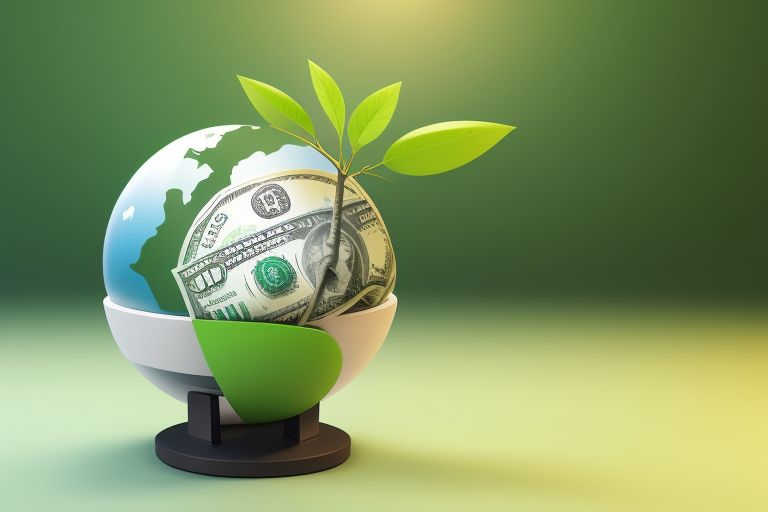Climate change is one of the greatest challenges today. It is not just an environmental issue but it is also affecting economies and markets globally. As temperatures rise the businesses and investors face risks and opportunities. How does climate change affect finances and how can investors both protect themselves and contribute to sustainability?
Financial Risks of Climate Change
Climate change spreads financial risks persistently. If anything is not done to save the environment, then the global GDP would decrease by as much as 18% by 2050 due to natural disasters, changes in farming, and increased sea levels, as reported in 2020.

Physical Risks
The destructive impacts of floods, hurricanes and droughts are leading to very high physical risks. Supply chains and properties are either destroyed or badly damaged as farmed agriculture and real estate industries are devastated. According to an estimate of the World Bank, climate-related disasters cause global economic loss of nearly $ 390 billion annually.
Transition Risks
As the clean energy-shifted world is placing tremendous concentrations of investment pressure upon those sectors that depend directly on fossil fuel products for production (such as oil producing firms and related industries). Similarly, according to the global experts there would be decrease in oil demand over the year. This would be gradually happened due to the global awareness of environmental protection concerns. Under these circumstances the investments in such highly environmental concentrated firms will have no worth.
Investing in a Climate-Conscious World
Today, many investors target sustainable investments such as Environmental, Social and Governance (ESG) investing. ESG investing, generally speaking considers an investment taking into account the impact that the company has on the environment, social responsibility and governance, among other considerations.
Expansion of ESG Investments
As the Global Sustainable Investment Alliance states, the 2020 figure already shows that ESG investments have reached $35.3 trillion- part of one-third of total global assets. Indeed, this proves that most investors finally seem to understand and respect a more aggressive balance of profit with what is for the environment. For instance, companies that deal with renewable energy have seen and are already experiencing an inevitable massive surge in stocks. For example, Tesla's stock jumped over 700% between 2019 and 2021 following the frenzy over clean energy.
Green Bonds
Green bonds are another way to invest in environmentally friendly projects. These bonds are issued to fund projects like renewable energy or clean water initiatives. In 2022 the global issuance of green bonds reached $500 billion. Investing in green bonds provides stable returns and supports sustainability which making them attractive for both individual and institutional investors.
Renewable Energy
Renewable energy is one of the clearest winners. Bloomberg reported that global investments in renewables reached $366 billion in 2021 and are expected to grow as countries push to lower emissions. Solar, wind and hydropower are becoming more popular as their costs continue to fall, making them a strong investment option.

Electric Vehicles (EVs)
The electric vehicle market is another booming sector. A report from Deloitte predicts that EV sales will reach 31.1 million by 2030 which making up nearly one-third of all vehicle sales. As governments introduce stricter emissions rules; the demand for EVs is set to rise which benefiting companies like Tesla, Rivian and traditional carmakers switching to electric models.
Building a Climate-Resilient Portfolio
Diversification is the key to protect investments from the risks posed by climate changes. A climate-resilient portfolio should balance sectors that may be negatively affected with those poised to grow.
Spread across Green Sectors
Investing in firms for green economy, such as renewable energy, EVs and sustainable infrastructure surely is a smart move. Most of them are not only growing but also aligned with future regulations. A diversified way to access such markets is available through exchange-traded funds.
Monitor for Transition Risks
Oil and gas might still provide short-term gains but the long-term prospects seem uncertain with stiff regulatory challenges and reduced demand. Gradual withdrawal of exposure to such industries and reinvestment in green industries can really help to avoid any such risks.

Building Wealth Through Awareness
An investor cannot be oblivious to the economic implications of climate change. All this measures can make the investor more adapt to strong and efficient investment portfolio and potential risk-awareness from options arising in sectors relevant to renewable energy, electric vehicles and green bonds. It can help to secure one's financial future investments and promises a better and sustainable world as well. Climate-conscious investing is about helping the planet while protecting your wealth at the same time.

The Rise of Sustainable Finance: Principles, Trends, and Market Impact

Understanding the Role of Financial Planning in Wealth Accumulation

The Rise of Mobile Banking: Trends, Benefits, and Security Challenges

Understanding the Role of Fiscal Policy in Economic Management

The Influence of Political Instability on Global Financial Markets

The Future of Financial Markets in the Context of Technological Disruption

Understanding Commodity Trading and Its Influence on Global Markets
